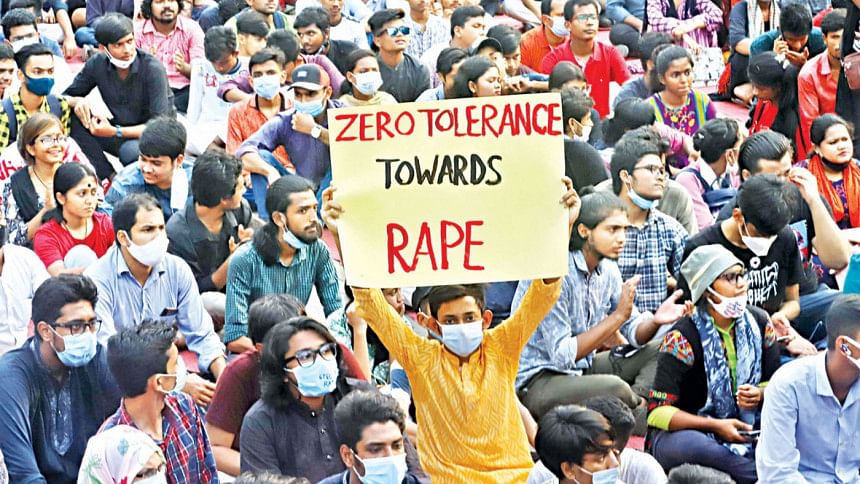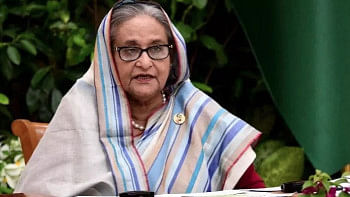Protests against rape give us hope. But is that enough?

After the video of the Noakhali gang rape went viral, people from all walks of life were rightly outraged and joined online and offline protests demanding reforms in the relevant law against women and children repression as well as the highest punishment for rapists. Not just the rise in incidents of rape but the sheer brutality of these crimes also sent shockwaves through the society. In the Noakhali case, the victim is a wife and a mother. She was stripped, gang-raped and beaten while it was videotaped by the perpetrators. What makes a rapist or rapists feel so empowered so as to videotape their own crimes and even release the clip to further dehumanise her? What makes them think they can get away with such heinous crimes (for, clearly, they wouldn't have released the video unless they thought so)?
I felt utterly helpless as I struggled to process the absurdity of the Noakhali case. So I started reading up on the root causes of rape and what makes a criminal go to such lengths. It is generally understood that rape can be addressed through strict laws, provided they are implemented properly—a vital requirement that, unfortunately, remains elusive in Bangladesh. But understanding this crime, and the criminals behind it, is also important in the fight to end the rape culture.
Before we dig into that, it's worthwhile to recall that at least 975 women were raped in the last 9 months, with 208 of them being gang-raped, according to Ain o Salish Kendra (ASK). Clearly, violence against women and rape has increased during the Covid-19 lockdown. As a society, we should be able to find a solution collectively, and detecting the rapist amongst us is the first step.
Rapists start early
A New York Times article, published in 2017 at the height of the #MeToo movement, talked about an interesting approach adopted by Dr Samuel D. Smithyman, a clinical psychologist in South Carolina. For his PhD thesis in 1976, he put up an advert on a newspaper asking rapists to call him, in order to understand "Why men rape". In the end, he conducted 50 interviews of "undetected" rapists. The idea was, unless we understand a criminal's behaviour, it will not be possible to understand the kind of crimes they commit. However, according to the article, rapists start non-consensual sex much early in life. They are also associated with others who share similar opinion regarding violence against women. Rapists who do not feel guilty also tend to be repeat offenders.
While I was reading this article, I was reminded of a Netflix series titled 13 Reasons Why, which deals with a teenage girl who was raped and eventually killed herself. The perpetrator in question was a rapist who repeatedly committed the crime in school, while his friends remained quiet. Many such boys roam around our girls, and yet we are unaware. It is important to teach our girls how to detect the undetected rapist, through active communication and dialogue. Girls should be able to speak up when they feel uncomfortable, instead of being shamed or silenced.
Rapists feel entitled to harass/abuse women
According to Antonia Abbey, a social psychologist at the Wayne State University in the US city of Detroit, many rapists think that women and girls often play hard to get. They are seen as sex objects and thus dehumanised. They are also thought of as inferior beings, and men who are rejected by them cannot handle that. As a result, men feel entitled to throw acid in their faces, harass or abuse them as they come from school or other places, sometimes in broad daylight, and even feel entitled to walk into their houses to rape them, etc. Through our tolerance or rather acceptance as a society, we have allowed rape and other forms of abuse and violence against women to be normalised.
Rapists are being enabled
We have had sexual harassment and rape normalised to a point where such incidents no longer produce shock, unless something jaw-droppingly awful happens, like the Noakhali incident. On any given day, rape for us is just another news item on the back or inside pages of a newspaper. This lack of sensitivity and awareness, among other reasons, is what enables a rapist in the first place. This is what made Delwar Hossain and his Bahini feel they could commit the gruesome crimes with impunity. To be honest, thugs like them have been historically utilised for various crimes, to instil fear into their communities, and they are never arrested or tried until it gets too "embarrassing" for the powers that be.
Many societies and cultures, including ours, have this distorted notion about consent when it comes to love and sex—that women often say no but secretly have no objection. This notion is often promoted in mainstream movies and pornography. Numerous movies, both home-grown and imported from Bollywood, show variations of a love story where the hero would "harass" the heroine in broad daylight, accompanied by his dancing troops, and in the end the heroine would fall into his arms. These movies had set in motion a gradual process of acceptance of such behaviours as "harmless". Think of the 1990 movie Dil, where Aamir Khan harasses Madhuri Dixit at night but she eventually falls in love with him! Or think of the 2019 movie Kabir Singh, where a hostile medical student literally makes a girl fall in love with him, who remains in love despite being slapped on the face in broad daylight. How can these movies be allowed to be released? And how do they become so popular if we are not endorsing them or the behaviour promoted in them?
Rapists have mental disorder
In 2017, Dr Shuvendu Sen, Associate Program Director, Internal Medicine Residency, Raritan Bay Medical Center, explained the characteristics of a rapist in the Times of India. One of them is mental disorder, which can happen during childhood and in adolescent years. Detecting such behaviour early on is vital, as is treating it through behavioural counselling, psychosocial support and allied therapies. We need to cure these minds before they get damaged beyond repair. This would mean undertaking a concerted effort including forming a better education system (teaching students the harmful effects of patriarchy), having healthier communities as well as empathy from religious leaders, corporate offices and community organisations that will work together with the law enforcers so that potential rapists are identified, before they commit such crimes.
To conclude, these are but some of the many causes and characteristics responsible for our enduring rape culture. There are legal, procedural, political and even societal reasons for why such incidents are on the rise. We need to identify them and prepare accordingly. For a wider impact, we need to instigate systematic changes through the involvement of our homes, communities, educational institutions, faith leaders, NGOs, and above all, the administration. Today, the problem is so profound and widespread that ordinary people sometimes feel helpless and don't know where to begin. As I write this, people are demonstrating and protesting across the country against the rise in sexual crimes. People are now more aware than before, more vocal and united in their demand to end the rape culture. This gives me hope, but is hope enough?
Tasmiah T. Rahman is In-charge, Skills Development Programme at BRAC, and an advocate of women's rights. Views expressed in the article are her own.

 For all latest news, follow The Daily Star's Google News channel.
For all latest news, follow The Daily Star's Google News channel. 



Comments